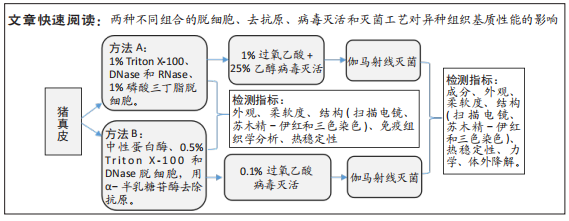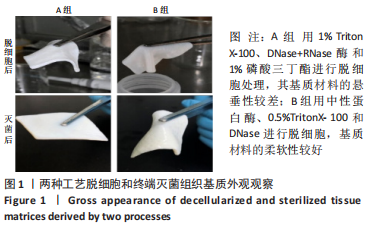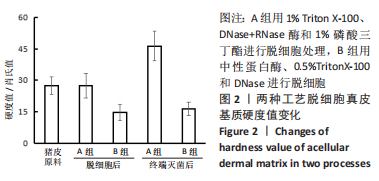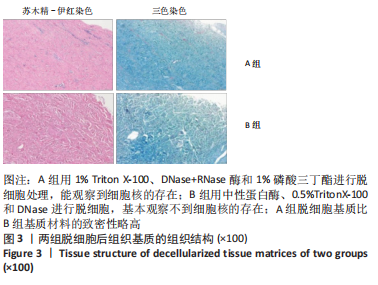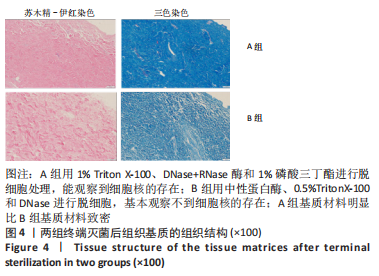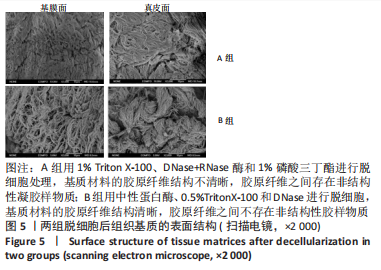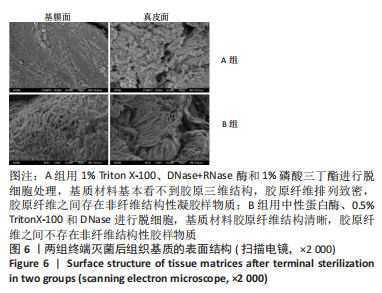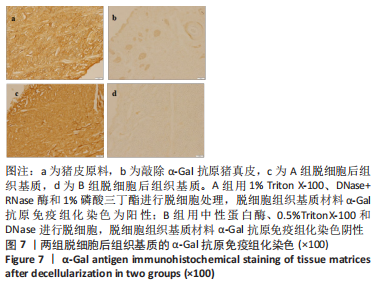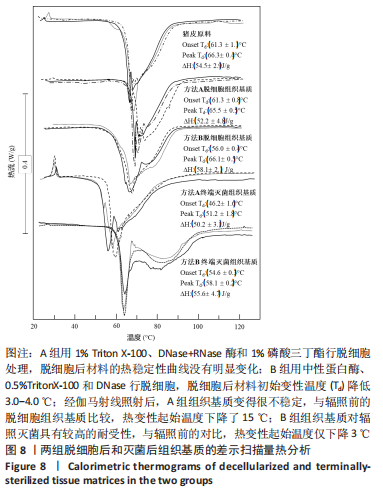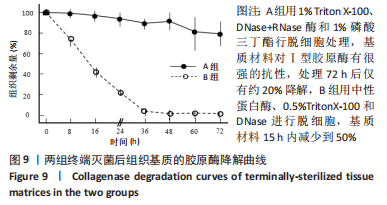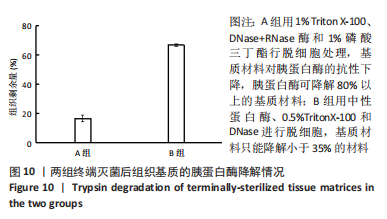[1] ZHANG X, CHEN X, HONG H, et al. Decellularized extracellular matrix scaffolds: recent trends and emerging strategies in tissue engineering. Bioact Mater. 2021;10:15-31.
[2] AMIRAZAD H, DADASHPOUR M, ZARGHAMI N. Application of decellularized bone matrix as a bioscaffold in bone tissue engineering. J Biol Eng. 2022; 16(1):1-18.
[3] LI T, JAVED R, AO Q. Xenogeneic Decellularized extracellular matrix-based biomaterials for peripheral nerve repair and regeneration. Curr Neuropharmacol. 2021;19(12):2152-2163.
[4] YAO Q, ZHENG YW, LAN QH, et al. Recent development and biomedical applications of decellularized extracellular matrix biomaterials. Mater Sci Eng C Mater Biol Appl. 2019;104:109942.
[5] CAPELLA-MONSONÍS H, ZEUGOLIS DI. Decellularized xenografts in regenerative medicine: From processing to clinical application. Xenotransplantation. 2021;28(4):e12683.
[6] MENDIBIL U, RUIZ-HERNANDEZ R, RETEGI-CARRION S, et al. Tissue-Specific Decellularization Methods: Rationale and Strategies to Achieve Regenerative Compounds. Int J Mol Sci. 2020;21(15):5447.
[7] EBRAHIMI SADRABADI A, BAEI P, HOSSEINI S, et al. Decellularized Extracellular Matrix as a Potent Natural Biomaterial for Regenerative Medicine. Adv Exp Med Biol. 2021;1341:27-43.
[8] SAFDARI M, BIBAK B, SOLTANI H, et al. Recent advancements in decellularized matrix technology for bone tissue engineering. Differentiation. 2021;121: 25-34.
[9] BUCKENMEYER MJ, MEDER TJ, PREST TA, et al. Decellularization techniques and their applications for the repair and regeneration of the nervous system. Methods. 2020;171:41-61.
[10] CHENG J, LI J, CAI Z, et al. Decellularization of porcine carotid arteries using low- concentration sodium dodecyl sulfate. Int J Artif Organs. 2021;44(7): 497-508.
[11] CRAPO PM, GILBERT TW, BADYLAK SF. An overview of tissue and whole organ decellularization processes. Biomaterials. 2011;32(12):3233-3243.
[12] NONAKA PN, CAMPILLO N, URIARTE JJ, et al. Effects of freezing/thawing on the mechanical properties of decellularized lungs. J Biomed Mater Res A. 2013;102(2):413-419.
[13] HUANG YH, TSENG FW, CHANG WH, et al. Preparation of acellular scaffold for corneal tissue engineering by supercritical carbon dioxide extraction technology. Acta Biomater. 2017;58:238-243.
[14] 张国安,宁方刚,钟京鸣,等.反复冻融配合超声振荡洗涤制备猪脱细胞真皮基质[J].中国组织工程研究与临床康复,2007,11(41):8280-8284.
[15] CHENG J, WANG C, GU Y. Combination of freeze-thaw with detergents: A promising approach to the decellularization of porcine carotid arteries. Biomed Mater Eng. 2019;30(2):191-205.
[16] TAYLOR DA, SAMPAIO LC, FERDOUS Z, et al. Decellularized matrices in regenerative medicine. Acta Biomater. 2018;74:74-89.
[17] CAI Z, GU Y, XIAO Y, et al. Porcine carotid arteries decellularized with a suitable concentration combination of Triton X-100 and sodium dodecyl sulfate for tissue engineering vascular grafts. Cell Tissue Bank. 2021;22(2): 277-286.
[18] HREBIKOVA H, DIAZ D, MOKRY J. Chemical decellularization: a promising approach for preparation of extracellular matrix. Biomed Pap Med Fac Univ Palacky Olomouc Czech Repub. 2015;159(1):12-17.
[19] KEANE TJ, SWINEHART IT, BADYLAK SF. Methods of tissue decellularization used for preparation of biologic scaffolds and in vivo relevance. Methods. 2015;84:25-34.
[20] WILSON SL, SIDNEY LE, DUNPHY SE, et al. Corneal decellularization: a method of recycling unsuitable donor tissue for clinical translation? Curr Eye Res. 2016;41(6):769-782.
[21] HUSSEIN KH, PARK KM, KANG KS, et al. Biocompatibility evaluation of tissue-engineered decellularized scaffolds for biomedical application. Mater Sci Eng C Mater Biol Appl. 2016;67:766-778.
[22] FERNÁNDEZ-PÉREZ J, AHEARNE M. The impact of decellularization methods on extracellular matrix derived hydrogels. Sci Rep. 2019;9(1):1-12.
[23] GOKTAS S, MATUSKA AM, PIERRE N, et al. Decellularization method influences early remodeling of an allogenic tissue scaffold. J Biomed Mater Res A. 2013;102(1):8-16.
[24] WANG F, ZHANG J, WANG R, et al. Triton X-100 combines with chymotrypsin: A more promising protocol to prepare decellularized porcine carotid arteries. Biomed Mater Eng. 2017;28(5):531-543.
[25] LIAO J, JOYCE EM, SACKS MS. Effects of decellularization on the mechanical and structural properties of the porcine aortic valve leaflet. Biomaterials. 2008;29(8):1065-1074.
[26] BROWN BN, FREUND JM, HAN L, et al. Comparison of three methods for the derivation of a biologic scaffold composed of adipose tissue extracellular matrix. Tissue Eng Part C Methods. 2011;17(4):411-421.
[27] SAJITH S. Comparative study of two decellularization protocols on a biomaterial for tissue engineering. J Clin Exp Cardiolog. 2017;8(523):1-3.
[28] RIEDER E, KASIMIR MT, SILBERHUMER G, et al. Decellularization protocols of porcine heart valves differ importantly in efficiency of cell removal and susceptibility of the matrix to recellularization with human vascular cells. J Thorac Cardiovasc Surg. 2004;127(2):399-405.
[29] 史新立,张东刚,陈冰.动物源性医疗器械的病毒灭活进展[J].中华损伤与修复杂志(电子版),2009,4(3):340-345.
[30] 李彩艳,王志超,刘灵飞,等.环氧乙烷灭菌和辐照灭菌在医疗器械灭菌中的应用[J].中国医疗器械信息,2020,26(17):175-176.
[31] AEBERHARD PA, GROGNUZ A, PENEVEYRE C, et al. Efficient decellularization of equine tendon with preserved biomechanical properties and cytocompatibility for human tendon surgery indications. Artif Organs. 2020;44(4):E161-E171.
[32] XU H, WAN H, ZUO W, et al. A porcine-derived acellular dermal scaffold that supports soft tissue regeneration: removal of terminal galactose-α-(1, 3)-galactose and retention of matrix structure. Tissue Eng Part A. 2009; 15(7):1807-1819.
[33] 刘明,张旗,王蕊,等.过氧乙酸-乙醇对同种骨植入材料中病毒的灭活效果研究[J].中国消毒学杂志,2010,27(3):241-243.
[34] 刘思扬,庄道民,董如华,等.60^钴辐照法对生物羊膜中人类免疫缺陷病毒灭活效果的研究[J].中国消毒学杂志,2015(3):217-218.
[35] URIARTE JJ, NONAKA PN, CAMPILLO N, et al. Mechanical properties of acellular mouse lungs after sterilization by gamma irradiation. J Mech Behav Biomed Mater. 2014;40:168-177.
[36] HODDE J, JANIS A, ERNST D, et al. Effects of sterilization on an extracellular matrix scaffold: Part I. Composition and matrix architecture. J Mater Sci Mater Med. 2007;18(4):537-543.
[37] 周沫,李幼忱,张乃丽,等.过氧乙酸-乙醇联合辐照灭菌对同种肌腱力学强度的影响[J].中国矫形外科杂志,2011,19(22):1898-1900.
[38] KANG HV, IM JH, CHUNG YG, et al. Comparison of two different decellularization methods for processed nerve allograft. Cell Tissue Bank. 2021;22(4):575-585.
[39] MORADI L, JOBANIA BM, JAFARNEZHAD-ANSARIHA F, et al. Evaluation of different sterilization methods for decellularized kidney tissue. Tissue Cell. 2020;66: 101396.
[40] Frank GP. Methods for tissue decellularization, US09566369B2 [P]. 2013.
[41] ZHIGANG L, XINHUA L. Method for preparing an animal decellularized tissue matrix material and a decellularized tissue matrix material prepared thereby, US20160199540A1[P]. 2014.
[42] BOONE M, DRAYE JP, VERWEEN G, et al. Real‐time three‐dimensional imaging of epidermal splitting and removal by high‐definition optical coherence tomography. Exp Dermatol. 2014;23(10):725-730.
[43] 许银峰,胡军,肖良宝,等.制备去细胞人体肌腱支架材料的实验研究[J].中华显微外科杂志,2013,36(2):144-148.
[44] CARTMELL JS, DUNN MG. Effect of chemical treatments on tendon cellularity and mechanical properties. J Biomed Mater Res. 2000;49(1):134-140.
[45] XING S, LIU C, XU B, et al. Effects of various decellularization methods on histological and biomechanical properties of rabbit tendons. Exp Ther Med. 2014;8(2):628-634.
[46] 程海明,陈敏,李志强.胶原及皮革等电点的表征方法综述[J].皮革科学与工程,2012,22(4):20-24.
[47] 白玉龙,高玉凤,衷鸿宾,等.同种异体及异种组织修复材料: 如何选用适宜的病毒灭活工艺[J].中国组织工程研究,2019,23(14):2261-2268.
[48] 金洹宇,银华,安艳.辐射技术在医用生物材料领域中的应用[J].辐射研究与辐射工艺学报,2011,29(5):261-265.
[49] FIDALGO C, IOP L, SCIRO M, et al. A sterilization method for decellularized xenogeneic cardiovascular scaffolds. Acta Biomater. 2018;67:282-294.
[50] HODDE J, HILES M. Virus safety of a porcine‐derived medical device: Evaluation of a viral inactivation method. Biotechnol Bioeng. 2002;79(2): 211-216.
[51] LIN Q, LIM JYC, XUE K, et al. Sanitizing agents for virus inactivation and disinfection. View. 2020;1(2):e16.
[52] 胡凯,陈维明,骆井万,等.过氧乙酸/乙醇对异体皮性能的影响[J].中国组织工程研究,2022,26(10):1537-1543.
[53] UNI EN ISO 11137-2-2015,医疗保健产品灭菌.辐射.第2部分:建立灭菌剂量[S].
[54] SUN WQ, LEUNG P. Calorimetric study of extracellular tissue matrix degradation and instability after gamma irradiation. Acta Biomater. 2008; 4(4):817-826.
[55] GOUK SS, LIM TM, TEOH SH, et al. Alterations of human acellular tissue matrix by gamma irradiation: Histology, biomechanical property, stability, in vitro cell repopulation, and remodeling. J Biomed Mater Res B Appl Biomater. 2010;84B(1):205-217.
[56] EDWARDS JH, HERBERT A, JONES GL, et al. The effects of irradiation on the biological and biomechanical properties of an acellular porcine superflexor tendon graft for cruciate ligament repair. J Biomed Mater Res B Appl Biomater. 2017;105(8):2477-2486.
[57] MA T, SUN W Q, WANG J. Thermophysical stability and biodegradability of regenerative tissue scaffolds. J Therm Anal Calorim. 2022:1-8.
|
